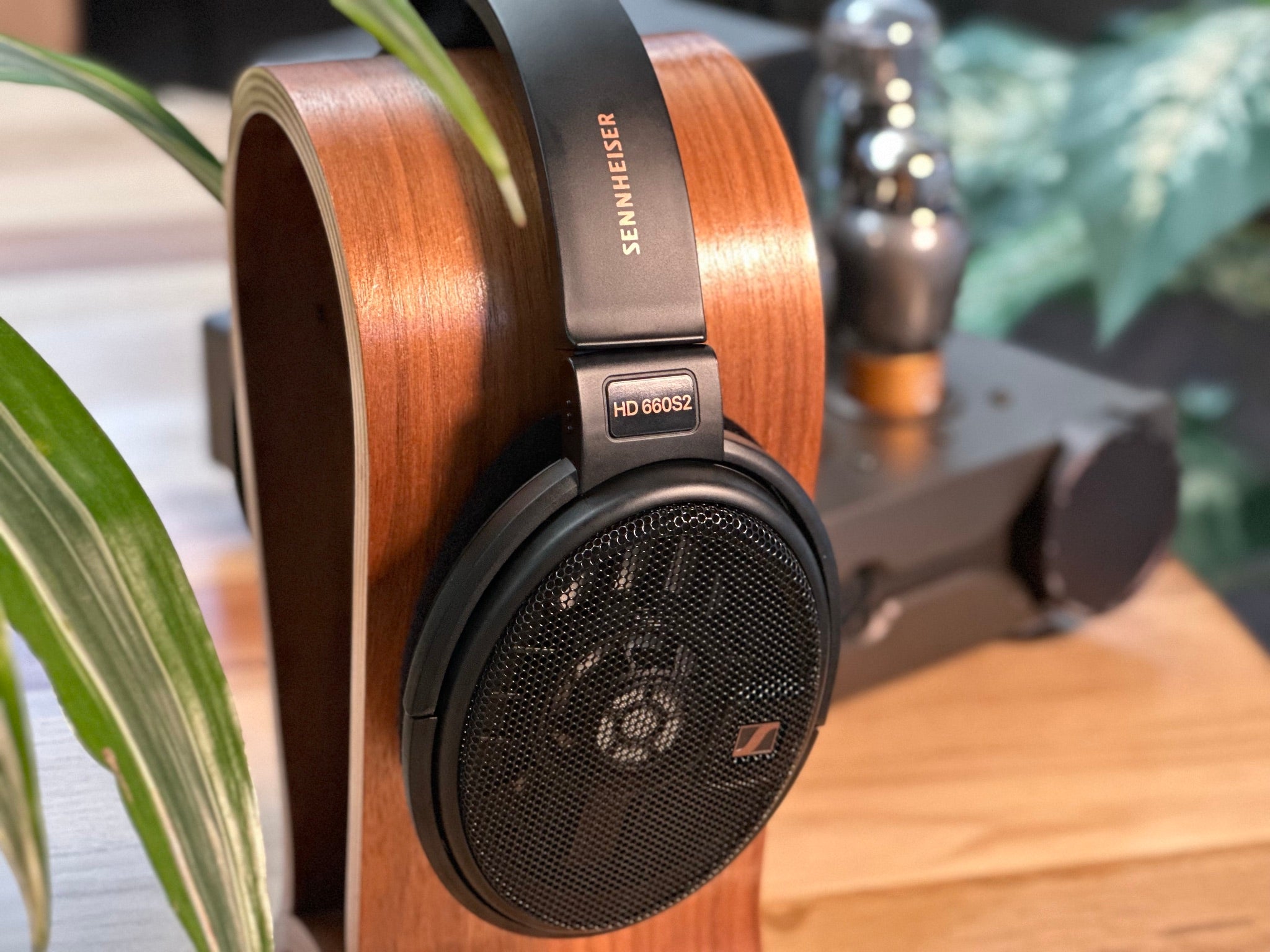Sennheiser continues its slow processing of dialing in the perfect reference sound with the release of the HD660 S2. While some Sennheiser headphones are in stores for decades, HD660S2 follows pretty closely on the heels of the original HD 660S, offering the same frame with subtle updates to the look and to the sound. As the new top of the HD 600 series, how does HD 660S2 stack up?
Build and Design
In terms of build, design, packaging, and all that, the headphone itself is nearly identical to the HD 660S, with the only difference – other than a 2 being appended to the model name – is that the color of the lettering is now a bronze color, rather than grey/silver of the previous model. HD 660S2 remains lightweight and comfortable, with a solid build. Internally though, HD 660S2 has a higher impedance 300ohm driver, more in line with previous entries in the HD 600 series. The heavy use of plastic may be off-putting to some at this price point, but it honestly feels better constructed than many magnesium based metal headphones at around the same price.
HD 660S2 opts for a smaller retail box without the fancy storage case HD 660S was packed in. It still provides 6.3mm and 4.4mm cables, but this time, they’re quite a bit shorter. The shorter cables will likely be more convenient for most users, as we found Sennheiser’s previous standard length cables to be too long for most uses – frequently creating a mess, or hanging down and getting tangled in desk chairs or other aspects of a workstation.
Like the HD 600 series as a whole, you can expect significant audio leakage with the HD 660S2. Even at low volumes, you’ll be broadcasting your music to those around you. The cables also use the same proprietary connector as other HD 600 and HD 500 series headphones, so while there are a number of cable options out there, it only works with the Sennheiser 2-pin headphone connectors.
Sound
For the most part, it takes a bit of a discerning ear to pick out the differences between different members of the HD 600 series, with each headphone largely adhering to the same target, with subtle differences separating each. With HD 660S2, you can expect detail, clarity, and a natural timbre, along with good air, and solid treble extension. While that’s largely true of its HD 600 brethren, what’s different with HD 660S2 is its deeper, more linear bass extension.
While the bass doesn’t match the extension and linearity of HIFIMAN Susvara, it has excellent depth and accuracy, with a natural, textured feeling, and an impact and punch that doesn’t compromise on energy either. These cans can definitely take a bit more bass too, as I was able to really crank it up with the RME ADI2 DAC’s EQ and add in quite a bit of additional bass without any noticeable distortion or clipping.
The midrange delivers on your expectations for Sennheiser, with thick, natural, layered mids that excel at vocals and acoustic instruments. Vocal presence is good, and balanced well between male and female vocals. The treble offers great details in the upper ranges of instruments and vocals, along with a highly resolving feeling.
HD660S2 delivers a great sense of weight in its imaging, with a holographic presentation. The soundstage itself is moderately sized, and not huge, but the space feels three dimensional. There’s a better sense of depth than width in some cases, with a stereo image that’s a little narrow, but with good depth and height to it.
The other big improvement that HD 660S brought to the HD 600 family that HD 660S2 continues is its efficiency. HD 660S2 remains more efficient than most other Sennheiser headphones, and will have good performance across a good range of devices – particularly anything with a 4.4mm output for that extra bit of juice from the balanced output.
On Adele’s “Someone Like You” the piano is soft and slightly muted. When the vocals come in, HD 660S2 places it right in front of you, with an intimate delivery mixed with a power that feels like it’s filling the whole room. The high notes are rich and full, with a visceral feeling that captures the emotion of the performance, and just barely avoids the more painful frequencies. The small vocal catches, and bit of grit are clearly heard and add a realism and sense of character to HD 660S2’s delivery of the song.
HD 660S2 gives a great texture to the out-of phase, fuzzed out guitar that starts Rush’s “The Spirit of Radio.” In the low end, you hear great cohesion between the bass drum and bass guitar, with a tight punch and a texture and color in each hit. Geddy Lee’s voice is smooth and clear – perhaps more clear than some would prefer – and each element stands out nicely from the mix. The detail and nuance to each part is incredible, from the dirty overdrive of the guitar, to the splash of the cymbals, and the bass guitar which moves effortlessly from smooth grooves to hard hits.
On the “Bat Cave Theme” from Danny Elfman’s Batman soundtrack, HD 660S2 gives a surprising level of space and separation to the sparsely arranged orchestra. The dynamics on the slow builds and fades are excellent, revealing the small details from the strings to the understated woodwinds, and providing both a natural sense of blending and cohesion, and a magnifying glass towards each part in the performance.
Comparison: Sennheiser HD 660S, iBasso SR3
For comparison, the first, most obvious choice is the HD 660S. The other is iBasso’s recent entry into the $500-$1000 headphone market, the SR3. What’s the best use of your budget right now: catch a HD 660S on the cheap? Upgrade to the HD 660S2? Or check out what iBasso brings to the table?
From a build perspective, the HD 660S models are essentially identical, while SR3 has more of a high-end audiophile look, with more of a distinct style, and some more premium feeling materials – though I don’t know if aspects like the hinges will demonstrate the same longevity as Sennheisers. SR3 is also the king of comfort, with a soft, relaxed fit that feels less fatiguing than the HD 600 series tighter grip on your ears.
In terms of sonic performance, it’s a slightly different story. I’m sure there will be mixed reactions from various corners of the audiophile community, but I find HD 660S2 to be a clear hands down improvement over the original HD 660S. The differences are relatively small, and are most noticeable in the bass, but after letting my ears “burn-in” to the HD 660S2, the original sounds a bit thin, as it’s missing the low end support that completes HD 660S2’s sound. The original HD 660S also doesn’t seem to derive any advantage in spaciousness or definition from its slightly brighter sound, making HD 660S2 the clear winner to my ears. HD 660S does have the advantage of being more efficient though, and may still be preferred for users with lowered powered devices.
It’s a different story with iBasso SR3, because there’s a wider spread in the tuning between the two. While HD 660S2 is still very much of a detail and clarity focused, reference headphones, SR3 maintains a neutral sound, but with a much more relaxed signature. SR3’s treble is clearly smoother with less air, while HD 660S2 has a little more bite. SR3 is also somewhat wider than HD 660S2, giving a more spacious sound, but without the Sennheiser’s more tactile holographic feeling imaging.
While a side by side comparison really demonstrates the improvements of HD 660S2 over the original, SR3 is more of a toss-up. For critical listening, or more intense, focused sessions, Sennheiser has an advantage, but if you’re just kicking back and relaxing to listen to some tunes, I’d grab the iBasso.
The Bottom Line
Most of Sennheiser’s recent innovation has come not in the form of massive fundamental changes to their sound, but slow incremental changes that differentiate the latest models with subtle improvements over previous revisions. In the case of HD 660S2, the subtle tweaks to the tuning provide a clear improvement, and let the headphone take the crown as the best sounding and performing HD 600 series headphone Sennheiser has made to date.









